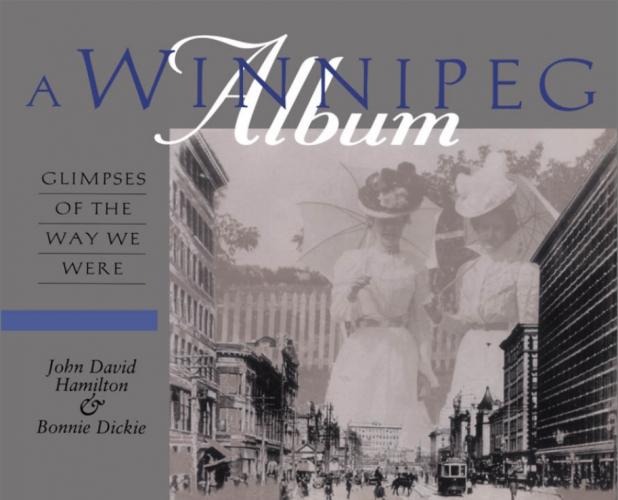. . . but there were crowds at times.
PAM - Winnipeg Buildings Collection - N4450
The family station wagon — an Indian family with a Red River cart.
PAM - Transportation Collection - N1428
Or you might prefer the latest 1880s model of a skidoo. (Dog teams in front of The Hudson’s Bay Company).
PAM - Winnipeg Buildings Collection - N9724
THE SETTLEMENT at The Forks began in violence with the Seven Oaks Massacre in 1816, when Nor’Wester buffalo hunters struck down Scottish settlers and continued with the first Riel rebellion in 1869. This was rough frontier country. The crooks and hustlers from Upper Canada had been stealing land from Metis settlers for a generation with the full support of the Queen’s government, and the Metis were finally lashing back. Louis Riel was hanged for his pains. His antagonist during the rebellion, Dr. John Schultz, lived on to become a knight of the realm and lieutenant-governor of Manitoba.
Apart from the rebellion, the transition from frontier fur-trading post to real city went with remarkable speed and efficiency. Winnipeg grew up at the Forks of the Assiniboine and Red — which became the corner of Portage and Main — while Riel’s home town of St. Boniface, across the Red, became a peaceful village, then a town.
Bakery in 1900 on what would become Tache Boulevard.
PAM - St. Boniface Streets Collection - N9368
Norwood Hotel.
PAM - St. Boniface Streets Collection - N9374
Whether you were laying out a lawn or turning the sod for the Red River railway to the States, that awful gumbo mud had to be dealt with.
PAM - Events Collection - N8942
More and more branch lines spread out — to the American border and to Hudson Bay.
PAM - Transportation Collection - 25
As soon as the railways arrived, farmers hitched up the old ox to the wagon and unloaded supplies.
PAM - Immigration Collection - N7934
The immigrants never stopped coming, and in 1915 they were surging in almost as fast as in 1910.
PAM - Foote Collection - N2066
By 1910, the CPR was a venerable institution and ready to make a monument of the first locomotive, the Countess of Dufferin, before an enthusiastic crowd.
PAM - Transportation Collection - N17
As the new postage-stamp province of Manitoba began to fill up, the settlers brought with them civilization on every level. Among the first institutions were the churches, which began as missions but soon took on a much more important role. The Roman Catholics and Anglicans had missions and schools in 1820; the Presbyterians came in the 1870s and the Methodists in the 1880s. For many years, Wesley College was the only high school in Manitoba.
Manitoba College (Presbyterian).
PAM - Foote Collection - N2694
St. Boniface College, Bishop’s Palace, and Cathederal.
PAM - St. Boniface Collection - N9360
New St. Boniface Roman Catholic Cathedral.
PAM - St. Boniface Collection - N11893
St. John’s College (Anglican).
PAM - Foote Collection - N2685
Wesley College (Methodist).
PAM - Winnipeg Views Collection - N11801
WESLEY COLLEGE was unique among the religious institutions of higher learning on the prairies. The Roman Catholics, Anglicans, and Presbyterians all sent their clergy out to minister unto the aboriginals and the newcomers and their colleges were largely used at first to train missionaries. But the Methodists had a broader perspective. For many years, Wesley College was the only high school in the province and it also threw open its doors to young people of all denominations. Until the Second World War at least, the non-sectarian University of Manitoba was segregated and had a quota system which kept out most Jews. It was also too expensive for poor immigrant boys and girls and its president, Sydney Smith, said publicly that only the well-to-do should be given a higher education.
But Wesley College, under Principal J.H. Riddell, welcomed everybody and kept its fees low. That meant there were many students who were the sons and daughters of impoverished clergymen and school teachers. But there were many Jews, Ukrainians, and other Central and Eastern Europeans, and even Canadian Indians.
We learned about one another and Wesley became perhaps the greatest force for tolerance in a province that had always been riven by religious and racial bigotry.
I am eternally grateful to my alma mater.
Religion came to the prairies with the La Verendryes, who built Fort Maurepas in 1734 near the Forks where the Assiniboine River joined the Red. This had been one of the great junction points of the world from time immemorial: here woodland and plains’ Indians met to trade — down the Red from the south, east along the Assiniboine from the true prairies, west along the Winnipeg River from the east, up the Red from Lake Winnipeg and the whole Saskatchewan River system.
Roman Catholic missionaries were at the Forks early and they were soon followed by Anglican and Presbyterian missionaries. As elsewhere, religion was a two-edged sword as far as the aboriginals were concerned. On the one hand, the missionaries tried to moderate the behaviour of the more rapacious white traders while at the same time bringing Christianity to the natives. On the other hand, Christian missionaries did their best to wipe out native religions and, indeed, all native culture.
Later, the Christian clergymen and Jewish rabbis were a pervasive influence on the new white settlers who poured in with the building of the railroads.
The early city of Winnipeg grew up around tiny Central Park, which in turn was close to several impressive churches, such as Knox Presbyterian.
The Rich
